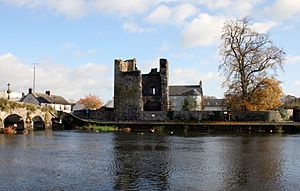Leighlinbridge Castle facts for kids
Quick facts for kids Leighlinbridge Castle |
|
|---|---|

The Black Castle on the River Barrow in Leighlinbridge
|
|
| Location | Leighlinbridge, County Carlow, Ireland |
| Built | 14th century |
| Rebuilt | 1547 |
| Architect | Edward Bellingham (1547) |
| Architectural style(s) | Norman |
| Reference no. | 438 |
Leighlinbridge Castle, also known as the Black Castle, is a historic site in Leighlinbridge village, County Carlow, Ireland. It stands right by the River Barrow.
This old castle was first built around 1181 by the Normans. Later, in the 1540s, a religious building called a Carmelite friary was turned into a strong fort by Edward Bellingham. Today, much of the castle is in ruins. You can still see a broken tower, about 50 feet (15 meters) tall, and parts of its outer wall.
Contents
Castle History: A Timeline
Early Beginnings: Norman Times
The first Norman castle was started around 1181. It was built by John de Clahull with help from Hugh de Lacy. This castle, along with a nine-arched bridge over the River Barrow, became very important for the town. Building the castle helped the town of Leighlinbridge grow.
Friaries and Other Castles
In the early 1270s, a group of monks called the Carmelites came to Ireland. They built their first religious house, called a friary, near the castle in Leighlinbridge. The bridge across the river was built later, around 1320.
Another castle, called the 'White Castle', was built nearby around 1408. It was built by Gerald FitzGerald, 5th Earl of Kildare. However, by the 1840s, there were no parts left of this White Castle, and people had forgotten exactly where it stood.
From Friary to Fort: A New Purpose
In 1543, the Carmelite friary was closed down. Then, in 1546, Edward Bellingham changed the friary into a strong fort with a surrounding wall. This new fort became a major military center for the entire region of Leinster. Bellingham also set up stables at the castle for about two dozen horses.
Battles and Changes
In 1577, Rory Oge O'More from Laois was said to have attacked the castle. At that time, George Carew was in charge of the castle. Some stories say the castle was captured and part of the town was destroyed. However, other accounts suggest the castle was not taken, and the attackers were pushed back from its gates.
During the 1590s, a big conflict known as the Nine Years' War took place. The castle was repaired and had more soldiers sent to protect it for the king. In 1604, the king gave the castle to George Tuchet, Lord Awdeley.
Later, during the Irish Rebellion of 1641, the castle was first held by the Catholic side. In 1647 and 1649, it was used as a meeting point by the Marquis of Ormond. Finally, in 1649, the castle was captured by Colonel Hewson for the forces of Oliver Cromwell.
What Remains Today
Castle Structure in the 1840s
In the 1840s, the castle ruins included a large rectangular outer wall. This wall was about 315 feet (96 meters) by 234 feet (71 meters) and roughly 7 feet (2 meters) thick. It was surrounded by a ditch, like a moat, on three sides, with the river on the fourth side.
The main part of the castle, called the keep, was built in the 15th century. It was a rectangular tower nearly 50 feet (15 meters) tall. By the 1840s, only one outer wall of the keep remained, along with one floor supported by an arch. There were also parts of a round tower in the southwest corner. This tower was about 24 feet (7 meters) tall with walls 10 feet (3 meters) thick.
Modern View of the Black Castle
Today, experts describe the Black Castle as a three-story tower house made of limestone. The lowest floor has a vaulted ceiling. The roof is surrounded by walls that have secret passages inside them. Both the tower and the rectangular outer wall, called a bawn, have openings for cannons or other weapons. These features show that the castle was built in the 16th century.

